Technology from Europe: the Netherlands
Supersonic separator gains market acceptance
High velocities make a unique separator and dewpointer.
Marco Betting and Hugh Epsom, Twister BV, the Netherlands
Launched in April 2001, Twister Supersonic Gas Conditioning technology was first put into commercial operation over three years ago, dehydrating sour gas with a 12-tube system at the Shell-operated B-11 platform offshore Sarawak. A fuel gas treatment system with 6 tubes is currently being built for the SPDC-operated Afam power plant onshore Nigeria. A FEED contract for using the technology at an offshore condensate stripping plant has been completed for the Nexus Energy Crux field in Australia. During the last two years, the technology has been further proved and extensively tested at the Gasunie Engineering & Technology facility in the Netherlands. The main performance data during this development and test period is presented in this article.
THE SUPERSONIC SEPARATOR
The Twister Supersonic Separator combines adiabatic cooling and cyclonic separation in a single compact device. Adiabatic cooling is achieved in a Laval nozzle—an aerodynamically shaped venturi tube— which achieves an isentropic expansion efficiency of typically 80%. The swirling motion is generated by a vane ring at the entrance of the Laval nozzle. The swirl strength increases strongly, due to contraction in the nozzle, resulting in a centrifugal field of about 500,000 g.
The fine, dispersed liquids formed during the adiabatic expansion are separated as a result of the centrifugal forces exerted by the strong swirling flow, and removed from the dry flow at minimum temperature and pressure with a separation efficiency of typically 95%. At the point where liquid/gas separation takes place, the total fluid velocity is around 400 m/s. The remaining kinetic energy in the separated flowstreams within the tube is transformed to increased static pressure in the diffuser section.
The new design incorporates an inner body, which allows the principle of conservation of angular momentum to be harnessed. CFD models confirm that the induced centrifugal force is greatly increased with this design. The inner body also ensures that the vortex is concentric, allowing the separation efficiency to be significantly improved. This results in a more stable flow and reduces the risk of liquid entrainment to the primary outlet.
Key components. This separator has no rotating parts and does not require the use of hydrate-inhibiting chemicals. It enables a simple processing facility with a high availability, suitable for normally unmanned operation. Figure 1 details the cross-section and key components of the tube design. The net result of this improved design is the same separation and dewpoint performance at a much lower pressure drop, or a significantly improved hydrocarbon separation and NGL recovery performance at higher pressure drops, which are comparable to those seen in conventional Joule Thompson and turbo-expander processes.
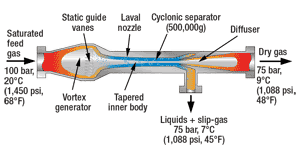 |
Fig. 1. Cross-section and key components of the tube design.
|
|
Twister has thermodynamics similar to a turbo-expander, combining expansion, cyclonic gas/liquid separation and re-compression in a compact, static, tubular device. A turbo-expander transforms pressure to shaft power; Twister achieves a similar temperature drop by transforming pressure to kinetic energy (i.e., supersonic velocity).
Since 1998, the company has obtained extensive full-scale experience with test units in five different gas plants in the Netherlands, Nigeria and Norway, as well as a commercial installation on the Sarawak Shell B11 platform in East Malaysia. These units have proved the viability of gas conditioning to typical pipeline specifications, as well as reliable and safe operation.
To enable the tube design, the company developed and validated a customized CFD code built on Ansys CFX software. This code is based on real gas equations of state and includes phase transitions. It incorporates the ability to model multi-component gases, including specific condensable components. It can be used to determine the droplet number and density of nucleation and includes a growth model to allow for change in droplet size through condensation and evaporation. The code validation has been achieved by correlation with actual Twister full scale test results. Twister makes this powerful design tool available to customers via Twister Flow Solutions, a separate engineering consultancy service, Fig. 2.
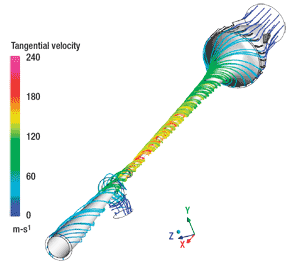 |
Fig. 2. CFD Image of new tube internals.
|
|
Commercial operation. Petronas and Sarawak Shell Berhad (SSB) successfully started up the first commercial Twister system on the B11 offshore gas processing facility (Fig. 3) in December 2003. That unit dehydrated 600 MMcfd of non-associated sour gas, which was fed to the onshore Malaysian LNG plant at Bintulu, Sarawak, to control pipeline corrosion. The dehydration system on B11 has now been in continuous operation for more than three years and has exceeded the guaranteed 98% availability.
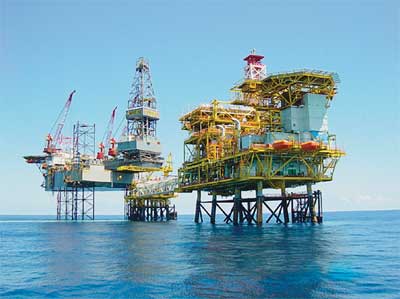 |
Fig. 3. Petronas/SSB B11 Platform.
|
|
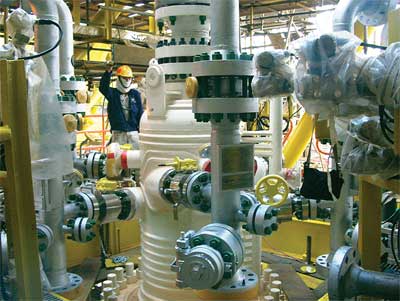 |
Fig. 4. System in use on the B11 Platform.
|
|
The system has two 60% parallel dehydration trains, each comprising six tubes mounted vertically around a Hydrate Separator (low temperature, liquid degassing vessel). The Hydrate Separator is a proprietary Twister BV design, based on conventional LTX technology using heating coils to melt hydrates, which has a liquid removal efficiency of over 98%. The produced hydrocarbon condensate is separately dehydrated and recombined with the export gas. Produced water is disposed offshore after treatment.
The operation of this system in a commercial green-field environment provided the opportunity to fully evaluate its performance under actual working conditions. The experience gained on B11 has been invaluable and has instigated significant further development improvements, including modifications of the design to further reduce the pressure drop. This decision resulted from the fact that the wellhead pressure is declining faster than expected, and there is a need to reduce the backpressure on the wells to extend B11 production capacity. For this reason, SSB requested that, during 2004, we develop a reduced pressure drop technology that will allow them to operate at a lower nominal inlet pressure.
Developing improved performance. The improved performance unit was developed and tested at the Gasunie Engineering & Technology (GET) test facilities in Groningen, the Netherlands. The two companies jointly constructed and installed a closed-loop, wet-gas test facility, which incorporates a twin-shaft multi-phase Bornemann pump (to compensate for the pressure loss in the loop), as well as a water-cooled heat exchanger (to remove the heat of compression). The test loop operates up to a feed pressure of 35 bar(g) and feed temperatures ranging between 15°C to 40°C. Different gas compositions were applied by filling the test loop with gas saturated with (combinations of) C3, C4, n-C5, n-C6, n-C7 and H2O vapor, Fig. 5.
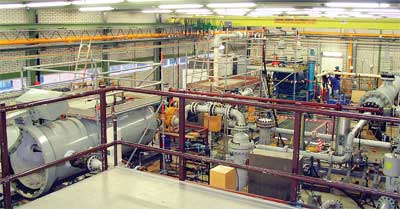 |
Fig. 5. Closed loop test facility (left: horizontal vessel containing tube. top: blue pump skid; right: water cooled HEX).
|
|
The cooperation between Twister BV and GET not only offered the possibility to operate a wet-gas test loop, but also the opportunity to use the broad Gasunie expertise and validated instrumentation for gas quality measurement, to assess the performance of the new design. During the performance tests, the hydrocarbon vapour fractions and water vapour fractions were monitored online in both the feed stream and the produced gas stream using Process Gas Chromatographs and the coulometric Karl Fischer titration methods. The produced liquid flow rate and liquid density was also measured online to verify the measured separation performance, Fig. 6.
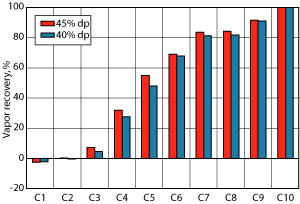 |
Fig. 6. Vapour recovery per component for new prototype (PGC analysis): Pin = 30 bar(g) Tin = 24�C.
|
|
Test performance. Four prototypes were tested during 2006. The first two were designed for low pressure drop dehydration and dewpointing applications, between 25 and 28% of the feed pressure. The last two prototypes were designed for a pressure drop of 40 to 45% of the feed pressure, to maximize liquids recovery. NGL recovery is maximized by designing a Laval nozzle with a deep expansion (i.e., an expansion ratio of five), which results in a higher pressure drop. The low pressure drop prototypes were based on an expansion ratio of two. The last prototype was also designed to maximize water recovery.
The results confirmed: very stable operation; reduction of pressure drop to 25% from 33%; liquid separation efficiency over 95% at a 45% pressure drop; C5+ removal and water recovery, both as predicted by CFD models. Tube performance is not affected by liquid carryover from the inlet separator.
Hydrocarbon recovery. The hydrocarbon recovery of components C1 to C12 measured during the closed-loop testing were compared with calculated values using simulation software; these showed good correlation with the predicted results. Figure 7 shows the comparison of measured hydrocarbon recovery compared with the simulation model for a 40 bar(g) inlet feed. These results also show an increase in recovery with carbon number, which demonstrates the improved NGL recovery performance.
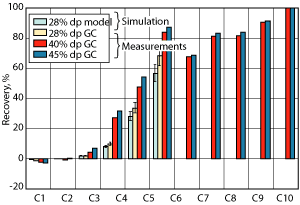 |
Fig. 7. Comparison of measured HC recovery with simulation model (feed 40 bar(g)).
|
|
It should be noted that a 70% C6+ recovery, with a 28% pressure drop tube, is equivalent to a 90% liquid separation efficiency. Further testing confirmed that a higher pressure drop across the tube further increases liquid recovery. At 45% pressure drop, the recovery of the low-boiling hydrocarbons was noticeably higher, while the C6+ recovery increased to 90% from 70%, which is equivalent to over 95% liquid separation efficiency.
Performance was also evaluated against a standard Joule-Thomson (JT) valve operating at the same process conditions. A JT-LTS system was tested in the same closed loop test system, replacing the tube. Figure 8 compares the true expansion lines between the two methods.
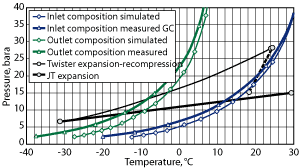 |
Fig. 8. True expansion lines of Twister system versus JT-LTS system.
|
|
The improved condensate recovery of the upgraded system is caused by a deeper and more isentropic expansion, compared to an isenthalpic expansion in a JT-LTS system at equal pressure drop. The effect of the expansion efficiency on the condensate recovery performance is especially visible in the lower pressure region, where the tests were performed.
The shift of the phase envelopes from blue (inlet) to green (outlet) is due to the condensate recovery performance of the device. It is clearly observed that in this low pressure range, a JT expansion will not yield any condensate. A similar difference between Twister and JT–LTS will occur in the higher pressure range. It is furthermore shown that the predicted hydrocarbon dew point lines (thin lines) are close to the measured hydrocarbon dew point line (bold lines), confirming the validity of the design models.
The conclusion is that the improved system achieves a much greater condensate recovery performance compared to a JT system, which clearly justifies the initial, new system investment cost—through an early payback from the incremental revenue stream and increased product volumes.
BENEFITS OF THIS TECHNOLOGY
This supersonic separation process is a simple, safe, environmentally friendly, quick start-up, gas conditioning system that enables chemical-free operation, high availability and normally unmanned operation. The compact and lightweight system facilitates a smaller platform size, which reduces the overall project cost for offshore applications. The ability to operate normally unmanned also facilitates significant operating cost savings in allowing the de-manning of offshore platforms and remote onshore locations.
Twister can be either optimized for dehydration and HC dewpointing applications at minimum pressure drop or for NGL recovery applications at higher pressure drops. A key benefit is the ability to simultaneously dehydrate, dewpoint and recover NGL, thus reducing the equipment required to meet the gas specification. In addition, Twister can achieve significantly higher condensate recoveries than a JT-LTS system.
The benefits of chemical-free NGL extraction is projected to play an important role in future gas plant optimization projects. Potential applications include:
- NGL stripping from field re-injection gas/lift gas
- NGL recovery from flare-gas
- LPG/NGL stripping from power plant fuel gas
- NGL recovery from pipeline transmission lines at pressure reduction points
FUTURE APPLICATIONS
Several opportunities have been identified for applying this technology, and engineering study work is in progress. This includes a recent FEED contract award from Nexus Energy Pty Ltd for potential application on its high-pressure offshore Crux gas/condensate field for the planned condensate stripping recycle project, Fig. 9. This is the only available technology that can efficiently recover condensate from the high-pressure gas stream (220–240 bar) with a simple, high availability system that enables significantly lower overall operating costs. Conventional TEG dehydration systems have a maximum operating pressure of typically 130 bar (caused by potential glycol carryover, due to the low density difference of the gaseous and liquid phases), and are liable to fail when operating near to their performance limit. TEG systems take 8 to 10 hr to get back online, whereas startup with this technology is instantaneous, since no gas-gas heat exchanger is required for this application, which would require a typical cool-down time of 20 to 30 min.
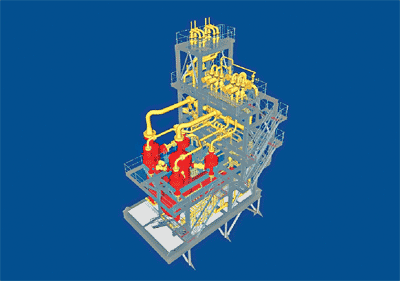 |
Fig. 9. Proposed system for the Crux Project.
|
|
The improved performance of this technology is expected to hasten installation on several commercial applications during 2008/9. A firm contract has been secured for one of these applications from Shell Petroleum Development Company, for an onshore 120 MMcfd fuel gas conditioning application at their new Okoloma Gas Processing facility. The installation comprises a single module containing a Hydrate Separator, six Twister tubes, as well as all associated valves, piping, instrumentation and control, Fig. 10. This system is expected to start up in late 2007.
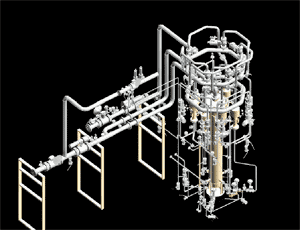 |
Fig. 10. Module for the SPDC Okoloma gas plant.
|
|
Significant potential has been identified for future application of this technology on various other gas processing separation applications, including deep LPG extraction, bulk removal of CO2 and H2 S, mercury removal and subsea gas processing. The company is working on a joint engineering study to develop an optimized system for deep LPG recovery applications. In addition, an agreement has been signed with Petrobras to enter into a joint technology development cooperation to design and test a system suitable for subsea applications.
CONCLUSIONS
Extensive full-scale testing and more than three years of commercial operation have proved the benefits of this technology, and operating experience to date has resulted in improved design criteria and the ensuing development of an improved performance unit that can be optimized for either dehydration and dew pointing or for condensate recovery.
Based on proven performance, the technology can now be applied for more stringent gas processing specifications, where water dew point suppressions of >25°C are required. The new improved performance unit has been shown to extract a significantly larger amount of condensate than a traditional Joule-Thomson (JT-LTS) process operating in the same pressure envelope. Closed loop testing has confirmed that the improved performance unit can, in addition to achieving chemical free dehydration at a lower pressure drop without the use of moving parts, also demonstrate a significantly improved hydrocarbon dewpointing and NGL recovery performance at higher pressure drops, approaching the performance achievable by a turbo-expander. The improved NGL recovery enables a useful revenue stream that allows early payback of the capital expenditure. 
|
THE AUTHORS
|
|
Marco Betting has 18 years’ experience in research and development of equipment for the process industry, working as a project manager for Stork Product Engineering and NAM. He joined the STV Twister team in 1998, initially as technology development engineer. He is currently the technology manager. Betting earned a BSc degree in Environmental Technology and an Executive Master degree on Energy Conversion Systems from Delft University of Technology in the Netherlands.
|
|
|
Hugh Epsom has 24 years’ experience in selling high value machinery to the oil and gas industry for Dresser-Rand and Ingersoll-Rand. Hugh joined Twister BV in 2002 as sales director. He earned a B.Tech degree in Mechanical Engineering from Loughborough University, England, and is a Fellow of the Institution of Mechanical Engineers.
|
|
|














